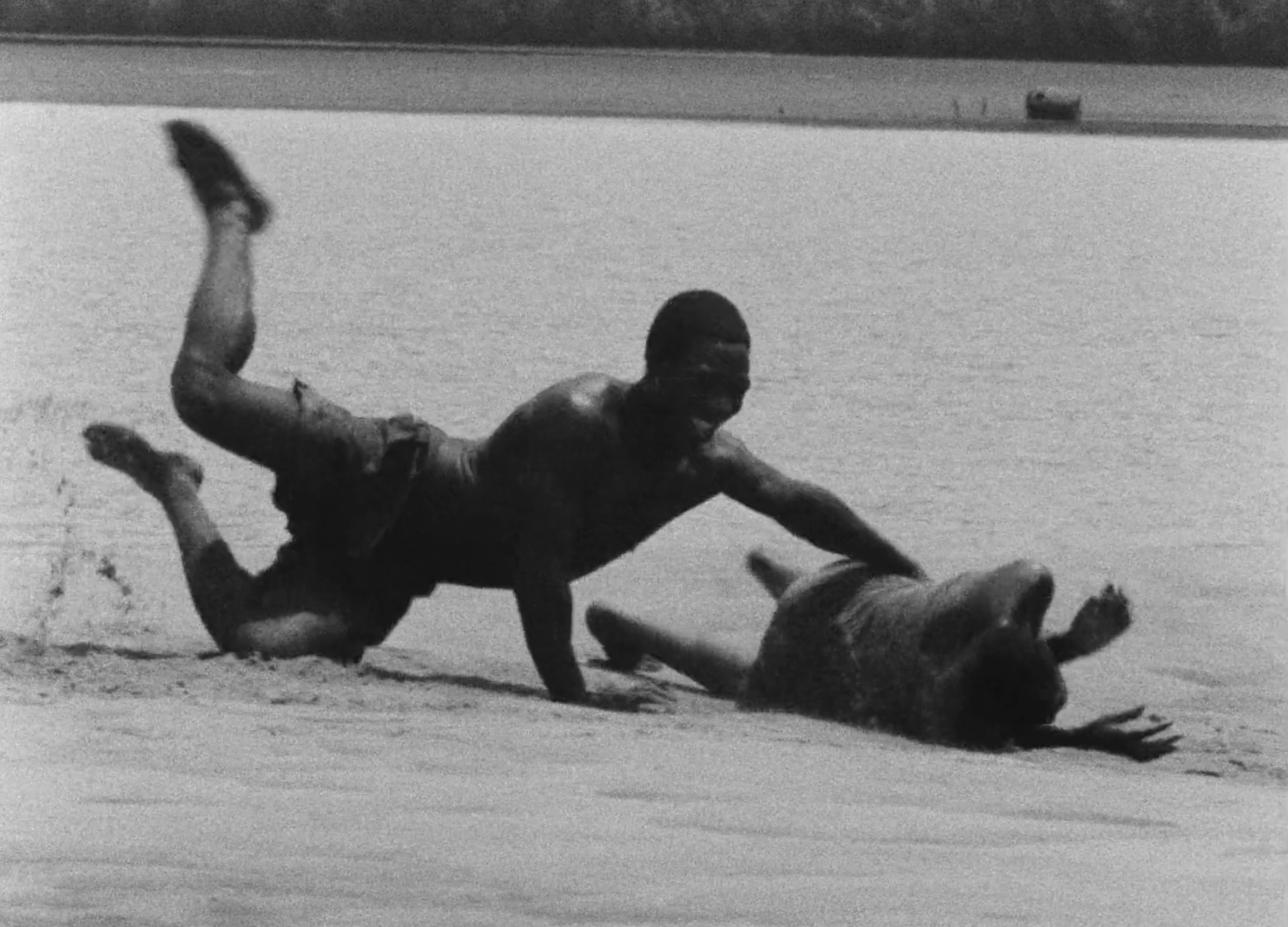Being unsettled is something that one comes to expect when being immersed in a film. Much of Syd Field’s gospel advice is centred around hanging your film on the pillars of a beginning, middle, and end regardless of the order in which you sandwich it. Given this is how we’ve been accustomed to receiving stories through this medium, accepting a surge of new narrative information – in any order – as the film opens onto us isn’t surprising. With Dikongué-Pipa’s Muna Moto, what unsettles me early is not the narrative flow of the film. As Douala prepares for its water festival, the camera peers into the mass of people pushing forwards. Ngando, evidently searching for someone – a woman, we can sense – reaches out to attract one’s attention. She turns back, and he stares at her in a palpable mixture of agony and disbelief. To us, the viewer, this fixation on the woman crashes truth onto falsehood. Is she the object of his search? Or another bitter reminder of the real object? Dikongué-Pipa begets meaning in this in-between of memory and mirage, and he does so throughout the film by placing it in Ngando’s moment of haste, child in hand, staring at his oppressor. Within this arrested moment, we see beginnings, false beginnings, ends, false ends – all mirroring the ambitions and realities of a plundered Africa. His venture, marking the first feature film for all of Cameroon, doesn’t seek to unsettle us through known highs and troughs. It unsettles us by placing us within an African stream of consciousness, a coup in visual forms that earns its narrator his artistic pedigree.
But a potential question to ask would be – does this choice of form, which earns the film its merits, meaningfully affect the dialectic of the film? Dikongué-Pipa still wishes to speak of oppression and a very particular type at that too. Should he have chosen to employ a much simpler structure that follows Ngando’s struggles against the marital order? One where we see – without changes in form – the workings of dowry accrete new desires in those who ultimately wield it over his head?
The film would have registered an impact had it done so, but it wouldn’t have marked the question as forcefully as it does by interweaving tangential memories, some aspiring to latch onto the might-have-been, all ultimately resemblant of the true state-of-mind of one forced to bear the yoke of a malformed social injunction. As he watches on from the banks of his uncle’s house, he firmly holds the shoe he affectionately bought for his child, a symbol of defiance. As he boots it into the river, we return to the image of him teetering on the edge of a pothole, his child nestled between his broad shoulders. The degrees of meaning here through a simple pairing of images, one that Kuleshov theorizes of in his works, derive directly from African modes of expression that codify human experiences through the non-verbal.
To allow these forms to stand and construct an unusual film grammar, it is important that Dikongué-Pipa only trains his discourse on the question of dowry in post-colonial Africa. Broadly, he wishes to speak of the place of women – his opening tribute acknowledges his wife and mother as ill-placed recipients of this system – in African society, yet the key question cottons onto her marital oppression. A woman’s right to choose her partner and the obstacles she encounters in doing so are more important in the stage of societal evolution that Africa finds itself in and choosing to map his film’s explorative form onto that as opposed to the multitude of economic, political, and geographic limitations she might face keeps the film rooted. Ndomé’s aspirations are simple, making the range of emotions she feels – as when Dikongué-Pipa hides her face during her shamefast declaration of pregnancy – much more charged as we see her choice deny her an identity within her society.
Muna Moto’s success – at least in critic circles and subsequent appreciation within Cameroon itself – is tied deeply with operationalizing the question of reform within one’s closely observed surroundings. When the film opens, we see Ndomé and Ngando, both lit dimly by the fires of her father’s hut. He palavers kindly, as they both listen, on the sanctity of marriage. A formulation of one plus one, where a unit is formed that separates only in death. There’s a winsome flicker that passes Ndomé’s face as her aspirations for life come close to reality. The film is then, on all fronts, a showcase of how the promise is consistently robbed from this singular unit that endeavours to fend off brambles from within. Attacked viciously is the notion of her value as a woman, with the ogles of Ngando’s uncle aimed at her fertility. To her, nonetheless, it is of sacred value – as we can understand from her promise to bear Ngando’s children. Autonomy, as we then come to realize, is then the central question of Dikongué-Pipa’s film and how traditional structures warp with colonial changes to unjustly deny the right to marriage of choice for their frivolous ends. Consequently, we are made to consider change as that which doesn’t reject or embrace culture categorically until the very end when they choose to flee the village. Even in progressing this question, Dikongué-Pipa holds culture as being valuable and doesn’t sound an ultimatum to place new possibilities outside of it.
There are equally larger questions being floated around this core too. The rivers are dried of fish, as Ngando’s uncle notes in his monologue, through the exploitative practices of the new industrial fishing boats. A despoiled Africa leaves little in the hands of few who wish to aggrandize their wealth through those who have none. The dowry that Ngando is made to work for reflects these conditions. There are other questions too, such as that of polygamy and fertility being an obsessive end for marriage. Ngando’s uncle is perverted by these values and is emboldened to seek a younger bride in Ndomé through his inherited fortunes, converging to impinge on her autonomy. His ability to muster up the dowry – sacks of Chinese rice and cases of Johnnie Walker – are also reminders of how materialism seeps into extant imbalances in tribal societies. These questions of polygamy and female value, economic and ecological loss, and post-colonial practices are each important in their own right, but within this narrative, they serve as reflectors that bring into focus the foremost question of autonomy concerning marriage.
The richness of this subtext, often left unspoken, is in line with other long passages of silence that are tied together by how Dikongué-Pipa uses the small, defective camera that was given to him as part of the project. The shots are often sized much closer – as when Ngando hears his father in a dream-like state – punctuating what is being spoken to him and his inability to respond in the face of forced acceptance. For Ndomé, too, the earlier mentioned declaration that strips her identity as a result of choice happens in a shot that narrowly focuses on her slender figure instead of her face. Both instances create a situation for the principal characters to have their voices denied in defining moments. When we do move out and behind, with expanded views of the landscape, we become spectators – of their lives, their ambitions, and the limitations that they contrive to work around. Their denied choices both come – within the frame – in an extremely personal space, one in which their implicit respect for their culture suffocates the evolution of their identity. The subtext that defines their milieu only notches up the solemnity.
Muna Moto, above all its achievements, is a cultural landmark that allows many around the world to engage with a culture they have heard the least from. Part of Scorsese’s World Cinema Project, the film accrues so much cultural capital given how it was brought to fruition despite the abysmal funding circumstances faced by Dikongué-Pipa and the evident non-preference it may have had in restoration over the years. In much of what I write, I always feel it to be necessary to engage with stories that revolve within a microcosm of a larger society for they can be reflective of large swathes of the world they don’t see. Muna Moto, despite its arduous journey to the present day, deserves to be kept alive by the far and few who see it for the generations to come. It stands to argue for the need to achieve reform within the bounds of one’s culture and to consider how falling prey to our base instincts can lock out our most vulnerable.



